Each state contributes differently to the American agricultural sector; here is what each is most known for
The United States is known for its strong agriculture industry, including advancements in research, technology, soil health, and so much more. All of that would not be possible without the hard working individuals that make up our industry. American agriculture is complex, and different regions of the country have different sectors that they specialize in. So it’s of interest to explore each state’s specialties and how they contribute to the greater food system. Whether we’re talking corn/soybean cropland, beef cattle, dairy, specialty crops, or something else entirely, below we list the top agricultural commodities of each of the 50 U.S. states.
Agriculture, food, and related industries contributed $1.109 trillion to the U.S. gross domestic product (GDP) in 2019, according to the most recent data from USDA’s Economic Research Service (ERS). Not only does the agriculture industry contribute to the economy, but it also provided jobs for 10.3 percent of total U.S. employment, or 19.7 million full- and part-time jobs.
The data below has been pulled from multiple reliable resources like state agriculture departments, each state’s Farm Bureau, the U.S. Department of Agriculture’s National Agricultural Statistics Service 2017 Census of Agriculture, the USDA’s ERS, and the USDA’s National Institute of Food and Agriculture(NIFA). The data shows the strengths of each state while also forming a strong foundation for our nation’s agriculture industry.
Here are the 50 states and a variety of unique strengths of each one:
Alabama
Agricultural cash receipts: $5.3 billion
Top ag commodity: Broilers
Land-grants: Auburn University; Alabama A&M University, Normal; Tuskegee University
Alabama is known for its strong agricultural background. Although broilers are the state’s number one commodity, cotton is the state’s number one planted commodity. However, Alabama’s largest manufacturing industry is forestry. That industry alone provides over 122,000 jobs statewide. There are over 40,000 farming operations in the state of Alabama and 8,580,000 acres of farmland, according to USDA’s National Agricultural Statistics Service. In addition to broilers, the next ranking commodities include chicken eggs, cattle and calves, miscellaneous crops, and cotton. Alabama even ranks third in the U.S. in sod production, with approximately 18,000 acres of sod.
View this post on Instagram
Alaska
Agricultural cash receipts: $38.7 million
Top ag commodity: Aquaculture
Land-grant: University of Alaska Fairbanks
Alaska is known as the biggest state of the union. However, as large as it is, few acres are deemed as cropable or could be used to raise livestock. Interestingly enough, 90 percent of Alaska land is owned by a government agency. According to the USDA’s National Agricultural Statistics Service, there are 990 farms and nearly 850,000 acres of farmland. The top five Alaskan commodities in terms of cash receipts are aquaculture, greenhouse and nursery production, vegetable production, hay production, and cattle and calves production. Alaska has just over 1,000 farms in its state.
Arizona
Agricultural cash receipts: $23.3 billion
Top ag commodity: Dairy
Land-grant: University of Arizona
Arizona has a strong and unique agriculture background. While generating over 138,000 jobs, the agriculture industry has roots in Arizona’s economy and affects every industry. Arizona is the third largest producing state for fresh market vegetables. Additionally, Arizona produced 455.7 million pounds of red meat and more than 4.2 billion pounds of milk. According to the Arizona Farm Bureau, Yuma, Arizona is the winter lettuce capital of the world. In fact, almost all of your leafy greens, broccoli and cauliflower are coming from Yuma, Arizona, during the winter months. Top commodities include dairy, lettuce, cattle and calves, miscellaneous crops, and hay.
Arkansas
Agricultural cash receipts: $9.5 billion
Top ag commodity: Broilers
Land-grants: University of Arkansas, Fayetteville; University of Arkansas at Pine Bluff, Pine Bluff
Agriculture is Arkansas’ largest industry, adding $9.5 billion into the economy. Not only is agriculture a major player for the state economy, but Arkansas also ranks No. 1 in rice production across the country. With agriculture playing a major role in the economy, it is no surprise that Arkansas has over 42,200 farming operations. After broilers, soybeans, rice, chicken eggs, and cattle and calves are the strongest commodities for Arkansas.
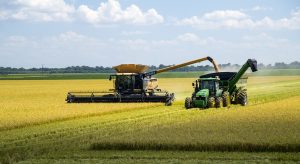
California
Agricultural cash receipts: $45 billion
Top ag commodity: Dairy
Land-grants: D-Q University; University of California System-Oakland
California has a very unique agriculture industry. With its climate and ability to grow commodities year round, California has a strong fruit and vegetable industry. California is also the world’s top producer of almonds! In addition to growing almonds, California grows over 400 commodities and is the fifth-largest supplier of food to the world. Top commodities include dairy, almonds, grapes, cattle and caves, and strawberries. With over 70,000 farming operations, the agriculture industry is vital to California’s economy and the nation’s fresh fruit and vegetable industries.
Colorado
Agricultural cash receipts: $7.49 billion
Top ag commodity: Cattle and calves
Land-grant: Colorado State University, Fort Collins
Colorado’s agriculture industry is known for its extensive cattle industry. The inventory for cattle and calves makes Colorado 10th in the nation with 2.8 million head, while also placing fifth in the U.S. with 1 million cattle on feed. Although that is a major portion of it, it is not the only industry supporting Colorado’s agriculture industry. There are nearly 39,000 farms and ranches in Colorado encompassing 31.8 million acres. That’s nearly half of the state’s total land area. To support the multiple farms, there are more than 170,000 jobs in Colorado related to agribusiness. Other top commodities include dairy products, corn, and hay.
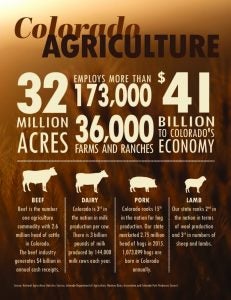
Connecticut
Agricultural cash receipts: $580 million
Top ag commodity: Nursery & horticulture
Land-grant: University of Connecticut, Storrs
Even though Connecticut is one of the smaller states, it still has a strong agricultural presence. With over 5,500 farm operations, Connecticut has over 12 percent of its land involved in agriculture. The top commodities include floriculture, dairy products, vegetables, poultry and eggs, and tobacco. Connecticut’s greenhouse and nursery products account for over 40 percent of the state’s total agricultural production.
Delaware
Agricultural cash receipts: $1.5 billion
Top ag commodity: Broilers
Land-grants: Delaware State University, Dover; University of Delaware, Newark
Delaware is a small state with a big agricultural punch! According to the 2017 Census of Agriculture, Delaware had 2,302 farms that produced $1.5 billion in agricultural sales. Delaware ranks No. 1 nationally in the value of agricultural sales per farmland acre at $2,791! Delaware’s top commodity, broiler production, annually accounts for over 75 percent of Delaware’s value of agricultural production. After that, top agricultural commodities includes corn, soybeans, and chicken eggs.
Florida
Agricultural cash receipts: $7.3 billion
Top ag commodity: Floriculture
Land-grants: Florida A&M University, Tallahassee; University of Florida, Gainesville
Florida is known as the Sunshine State, which means it can grow a variety of crops that many other states can not. For example, Florida ranks first in the U.S. in the value of production of cucumbers, grapefruit, squash, sugarcane, fresh market tomatoes, radishes, guavas, mangoes, passion fruit, watermelon, and kumquats. But more notably, Florida had 474,540 total citrus acres — which is 57 percent of the national total. With over 47,500 farm operations in Florida and 9.7 million acres of farmland, the agriculture industry supports 2.4 million fulltime and part-time jobs. Top commodities in the state include nursery and floriculture, fruits, vegetables, crops and hay, and cattle and calves.

Georgia
Agricultural cash receipts: $9.5 billion
Top ag commodity: Poultry
Land-grants: Fort Valley State University, Fort Valley; University of Georgia, Athens
Although Georgia is known for its peaches, it actually leads the nation in poultry, peanut, and pecan production, while ranking third in peaches. The highest ranking, poultry, actually accounted for 57 percent of Georgia’s total market value of products sold. According to the 2017 Census of Agriculture, Georgia peanut producers also harvested 827,627 acres of peanuts and produced a record high 3.58 billion pounds of peanuts — half of the U.S. total peanut production. According to the Georgia Farm Bureau, 42,000 farms support one in seven Georgians to work in agriculture, forestry or related fields. Top commodities include poultry and eggs, cotton, peanuts, chicken eggs, and pecans.
Hawaii
Agricultural cash receipts: $563 million
Top ag commodity: Macadamia nuts
Land-grant: University of Hawaii, Honolulu
Not only is Hawaii a beautiful state, it also has a unique agriculture industry. According to the 2017 Census of Agriculture, the Aloha State leads the United States in macadamia nut, papaya, passion fruit, taro, bananas, coffee, pineapple, and ginger root acreage. With over 7,000 crop and livestock farms the state is a growing hub for agriculture. Ag Census data show aquaculture sales increased from $57 million in 2012 to $74 million in 2017 in Hawaii. Other top commodities include fruits, floriculture, vegetables, and aquaculture.
Idaho
Agricultural cash receipts: $7.5 billion
Top ag commodity: Dairy products
Land-grant: University of Idaho, Moscow
Idaho’s agriculture industry is diverse and vitally important for its economy. Generating over $7.5 billion, the 25,000 crop and livestock farms make a major impact. Just how popular is agriculture in Idaho? According to the 2017 Census of Agriculture and the U.S. Census Bureau, there were over 700,000 more cattle than people in Idaho in 2017. In addition to having a large cattle population, Idaho ranks first nationally in potatoes, peppermint, alfalfa hay, and trout. Top commodities for the state include dairy products, cattle and calves, potatoes, wheat, and hay.
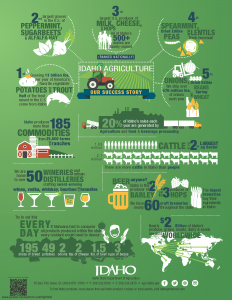
Illinois
Agricultural cash receipts: $17 billion
Top crop: Corn
Land-grant: University of Illinois, Urbana
With over 27 million acres of farmland — about 75 percent of the state’s total land area — Illinois has a strong agriculture industry across its 72,000 farms. There were more than 116,000 producers on Illinois farms in 2017 and more than 33,000 of them were women. Although Illinois agriculture is known for its production of corn and soybeans, it ranks first in the nation in pumpkin and horseradish production. Illinois also ranks third nationally in the export of agricultural commodities with $8.2 billion worth of goods shipped to other countries. Top commodities include corn, soybeans, hogs and cattle and calves.
Indiana
Agricultural cash receipts: $11 billion
Top crop: Corn
Land-grant: Purdue University, West Lafayette
Indiana, known for its robust corn and soybean production, is the eighth-largest agricultural exporter in the nation. There are over 56,000 farming operations throughout the state, working on just over 15 million of farmland acres, according to the Indiana State Department of Agriculture. Indiana ranks nationally in several areas of the agricultural sector, coming in first in duck production and second in popcorn, processed tomatoes, and total eggs. It also has Top 5 placement with products such as pumpkins, corn for grain, soybeans, and watermelons.
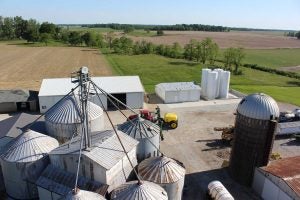
Iowa
Agricultural cash receipts: $29 billion
Top crop: Corn
Land-grant: Iowa State University, Ames
Iowa is another state known for its strong crop production abilities. Coming in behind California, Iowa ranks second in dollars generated from agriculture sales. The state is known for its strong crop production, combined with their livestock industry — Iowa has 86,000 farms in its state. Top commodities for Iowa include corn, hogs, soybeans, cattle and calves, and poultry and eggs. The Iowa agriculture industry is responsible for 1 out of every 5 jobs in the state.
Kansas
Agricultural cash receipts: $18 billion
Top crop: Cattle and calves
Land-grants: Haskell Indian Nations University, Lawrence; Kansas State University, Manhattan
There is no denying Kansas has a strong agriculture community. With over 58,500 farming operations, farmers and ranchers take their jobs to provide for future generations very seriously. Top commodities include cattle and calves, corn, soybeans, wheat, and sorghum. For example, Kansas ranked No. 1 for sorghum production in the nation with 194 million bushels produced — which accounted for 55 percent of all grain sorghum.
Kentucky
Agricultural cash receipts: $5.7 billion
Top crop: Poultry and eggs
Land-grants: Kentucky State University, Frankfort; University of Kentucky, Lexington
Results from the 2017 Census of Agriculture show that producers raised and sold over $5.7 billion worth of crops and livestock. Although Kentucky is known worldwide for its connection to raising and breeding horses, its production of chickens and eggs actually ranked highest in terms of sales according to the census. Other top commodities included horses, soybeans, corn, and cattle and calves. With nearly 80,00 farms, Kentucky producers and agricultural production represented 6.4 percent of total state GDP.
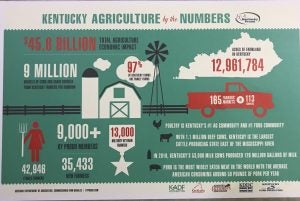
Louisiana
Agricultural cash receipts: $3.1 billion
Top crop: Soybeans
Land-grants: Louisiana State University, Baton Rouge; Southern University and A&M College, Baton Rouge
Although Louisiana might be known best for its Mardi Gras parades, there is also so much to celebrate here in the agriculture industry. With over 27,000 farms, the value of agricultural products sold in 2017 was over $3.1 billion in Louisiana. According to the 2017 Census of Agriculture, Louisiana ranked third in U.S. rice production, with producers harvesting nearly 398,000 acres. When talking about Louisiana agriculture you also have to highlight the growing crawfish industry. Crawfish producers reported nearly $59 million in sales, up 74 percent from 2012. Top commodities for Louisiana include soybeans, broilers, corn, rice, and sugarcane.
Maine
Agricultural cash receipts: $668 million
Top commodity: Potatoes
Land-grant: University of Maine, Orono
Maine farmers are the stewards of many diverse commodities across 1.25 million acres. Maine has 7,600 farms that provide $668 million in agricultural cash receipts to the state. Maine leads the nation in wild blueberry production and ranks second for maple production, but potatoes actually lead the state for Maine’s biggest commodity. Other top commodities include miscellaneous crops, potatoes, dairy products, chicken eggs, and turkeys.
Maryland
Agricultural cash receipts: $2.2 billion
Top commodity: Broilers
Land-grants: University of Maryland, College Park; University of Maryland Eastern Shore, Princess Anne
Don’t let the size of Maryland fool you, its agriculture industry is just as diverse as the soils that make up the state — everything from sandy beaches to the Appalachian Mountain soil. With nearly 12,500 farms, Maryland’s agriculture industry brought in $2.2 billion in agricultural receipts in 2019. Top commodities include broilers, miscellaneous crops, corn, soybeans, and dairy products. According to Maryland State Archives, agriculture also remains the largest single land use in the state, 2 million acres, or roughly 32 percent of total land area used for farming in 2019.
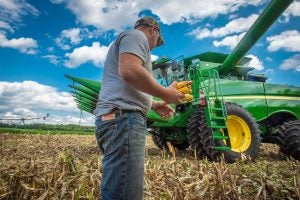
Massachusetts
Agricultural cash receipts: $475 million
Top commodity: Greenhouse and nursery
Land-grant: University of Massachusetts, Amherst
Massachusetts agriculture industry is supported by 7,241 farms on 491,653 acres. Although it might be small in numbers, the Massachusetts agriculture industry ranks in the Top 10 nationally for the number of farmers markets and direct sales of farm products to consumers. The agricultural industry directly provides employment to 25,920 individuals and produces an annual market value of over $475 million in agricultural goods. Top commodities include greenhouse and nursery, vegetables, cranberries, dairy products, and apples.
Michigan
Agricultural cash receipts: $8.2 billion
Top commodity: Dairy products
Land-grants: Michigan State University, East Lansing; Saginaw Chippewa Tribal College, Mount Pleasant
Michigan agriculture is a very diverse industry with a widespread impact. Michigan farmers produce over 300 agricultural products, making it one of the most agriculturally diverse states in the nation. Top commodities include dairy products, corn, soybeans, cattle and calves, and floriculture. However, with its over 47,500 farms, Michigan farmers also rank No. 1 in the nation for asparagus, tart cherries, black beans, winter squash, and turnips. With $8.2 billion in agricultural cash receipts and 17 percent of the state’s employment being connected to the industry, agriculture is vital to Michigan’s economy.
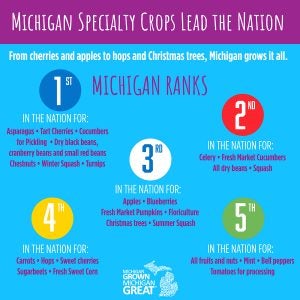
Minnesota
Agricultural cash receipts: $18.4 billion
Top commodity: Corn
Land-grant: University of Minnesota, St. Paul
According to the 2017 Census of Agriculture, Minnesota ranks sixth in the United States for the value of agricultural products sold. In 2017, Minnesota producers, which includes 68,800 farms, sold nearly $18.4 billion worth of products. Top commodities include corn, soybeans, hogs, cattle and calves, and dairy products. Minnesota also ranks tops in the nation for sugar beets, green peas for processing, and turkeys.
Mississippi
Agricultural cash receipts: $6.2 billion
Top commodity: Broilers
Land-grants: Alcorn State University, Lorman; Mississippi State University, Starkville
The 2017 Census of Agriculture showed that producers raised and sold $6.2 billion in crops and livestock. Not only does Mississippi have a strong crop and livestock industry, but its aquaculture industry actually ranks No. 1 in the nation. Top commodities include broilers, soybeans, cotton, corn, and catfish. With 35,000 farms across the state spreading over 10.4 million acres, it is no wonder that agriculture plays such an important role in the economy.
Missouri
Agricultural cash receipts: $10.5 billion
Top commodity: Soybeans
Land-grants: Lincoln University, Jefferson City; University of Missouri, Columbia
Missouri has a robust agriculture industry. For example, just behind Texas, Missouri ranks second in the nation for number of farming operations with 95,320. Top commodities from those farms include soybeans, cattle and calves, corn, hogs, and broilers. According to the 2017 Census of Agriculture, Missouri was the biggest elderberry growing state in the country in 2017, with 47 percent of U.S. acres. With the large presence of agriculture in its economy, Missouri agriculture employs nearly 400,000 people across the state, according to the Missouri Department of Agriculture.
Montana
Agricultural cash receipts: $3.5 billion
Top commodity: Cattle and calves
Land-grant: Montana State University, Bozeman
Agriculture is an essential part of Montana’s economy as it is the No. 1 industry in the state. With $3.5 billion in agricultural cash receipts and over 27,000 farms, Montana’s producers are vital to the success of the industry. Even more vital to the economy is the jobs the agriculture industry provides to Montana — one out of every six Montana workers is employed in an agriculture-related field. Montana’s cattle industry makes up the largest fraction of sales with 37 percent overall. Montana’s top commodities include cattle and calves, wheat, hay, barley, and miscellaneous crops.
Nebraska
Agricultural cash receipts: $21.4 billion
Top commodity: Cattle and calves
Land-grant: University of Nebraska, Lincoln
With a mascot with the nickname Cornhuskers, you know the state is centered in agriculture. Nebraska is known for its deep roots in agriculture including, having robust livestock and crop industries across its 46,000 farms. Top commodities include cattle and calves, corn, soybeans, hogs, and dairy products. Nebraska ranks first in popcorn production and the second largest ethanol producing state in the nation.
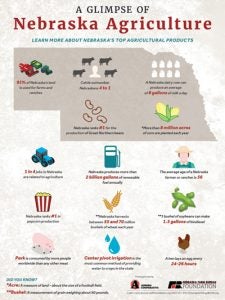
Nevada
Agricultural cash receipts: $709 million
Top commodity: Cattle and calves
Land-grant: University of Nevada, Reno
With a big contribution to the state’s economy, never bet against agriculture in Nevada! The agriculture industry generated $709 million in cash receipts in 2019. But one of their largest contributions is their farming operations. According to the 2017 Census of Agriculture, over 3,400 farm operations cover more than 6.1 million acres or 8.7 percent of Nevada. The average farm size in Nevada — 1,790 acres — is the third largest average for all U.S. states. Top commodities include cattle and calves, hay, and dairy products.
New Hampshire
Agricultural cash receipts: $199 million
Top commodity: Nursery and floriculture
Land-grant: University of New Hampshire, Durham
Although New Hampshire may not have the highest ranking agriculture contributions across the country, its still has a very unique industry. Top commodities include nursery and floriculture, dairy products, chicken eggs, turkeys, and cattle and calves. However, the state also has a strong apple and maple production as well. With $199 million in agricultural cash receipts contributing to the economy and over 4,100 farms, agriculture is a viable industry integrated within the New Hampshire economy.
New Jersey
Agricultural cash receipts: $1.2 billion
Top commodity: Miscellaneous crops
Land-grant: Rutgers University, New Brunswick
According to New Jersey’s Department of Agriculture, food and agriculture is New Jersey’s third largest industry, behind pharmaceuticals and tourism. The state’s 9,800 farms created over $1.2 billion in agricultural cash receipts. Top commodities include miscellaneous crops, floriculture, blueberries, bell peppers, and chicken eggs. In addition to those commodities, New Jersey is one of the top 10 producers of blueberries, cranberries, peaches, tomatoes, bell peppers, eggplant, cucumbers, apples, spinach, squash, and asparagus.
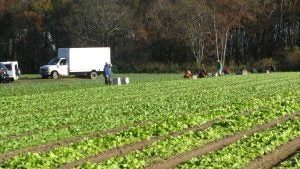
New Mexico
Agricultural cash receipts: $3.2 billion
Top commodity: Dairy
Land-grant: New Mexico State University, Las Cruces
With over 25,000 farms, New Mexico’s farmers and ranchers contributed in over $3.2 billion in agricultural cash receipts. According to the 2017 Census of Agriculture, New Mexico ranked first in the nation for chile pepper acreage with 8,313 acres. However, the state’s top commodities include dairy, cattle and calves, miscellaneous crops, pecans, and hay. The state has constantly been increasing the number of farms throughout the state. For example, in 2002, there were only 15,170 farms. However, that number grew by about 9,800 in 2017 for a total of 25,044!
New York
Agricultural cash receipts: $5.3 billion
Top commodity: Dairy products
Land-grant: Cornell University, Ithaca
Although New York is known for its fast-paced lifestyle, the agriculture industry is very important to its economy. According to the USDA’s 2017 Ag Census, there were 33,438 farms in New York State and 6,866,171 acres in production. All sectors of agriculture, including processing, are responsible for nearly 200,000 jobs in New York. According to the New York Farm Bureau, the state ranks first in yogurt, cottage cheese, and sour cream in the nation. In addition, apples, snap peas, maple syrup, and cabbage received a second place ranking. However, the state’s top commodities include dairy, miscellaneous crops, corn, cattle and calves, and apples.
North Carolina
Agricultural cash receipts: $10.6 billion
Top commodity: Broilers
Land-grants: North Carolina A&T State University, Greensboro; North Carolina State University, Raleigh
North Carolina’s agriculture economy is supported by 46,000 farming operations, which brought in $10.6 billion in agricultural cash receipts in 2019. This strong economic impact also supports over 70,000 jobs in the Tar Heel State. Top commodities include broilers, hogs, turkeys, miscellaneous crops, and soybeans. North Carolina also ranked first in the nation for tobacco, sweet potatoes, and poultry and eggs.
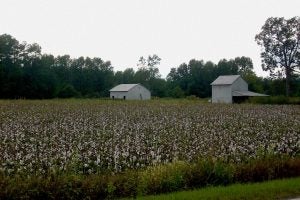
North Dakota
Agricultural cash receipts: $7.6 billion
Top commodity: Soybeans
Land-grant: North Dakota State University, Fargo
The 2017 Census of Agriculture showed that North Dakota farmland covers roughly 39.3 million acres, which is a whopping 89 percent of the total land in the state. Top commodities that cover the farmland include soybeans, wheat, corn, cattle and calves, and canola. However, the census also showed that North Dakota ranked first in the nation for the production of all dry edible beans, navy beans, pinto beans, canola, flaxseed, honey, dry edible peas, Durum wheat, and spring wheat. With its diverse agriculture industry, North Dakota generated $7.6 billion in agricultural cash receipts across 26,000 farms.
Ohio
Agricultural cash receipts: $8.5 billion
Top commodity: Soybeans
Land-grants: Central State University, Wilberforce; Ohio State University, Columbus
According to Ohio Farm Bureau, food and agriculture is the top contributor to Ohio’s economy and provides one of eight jobs in the state. The strong economic contribution is supported by the 77,800 farms and continues to lead the way in hardworking farmers and ranchers . Top commodities of those farms include soybeans, corn, dairy products, hogs, and cattle and calves. Ohio farmland includes nearly 14 million acres to grow and cultivate these commodities.
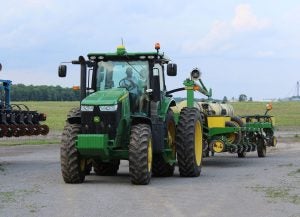
Oklahoma
Agricultural cash receipts: $6.7 billion
Top commodity: Cattle and calves
Land-grants: College of the Muscogee Nation, Okmulgee; Langston University, Langston; Oklahoma State University, Stillwater
According to the 2017 Census of Agriculture, Oklahoma’s animal industry showed the largest increase in sales between 2017 and 2012 with a 13 percent increase. Oklahoma is known for its strong connection to animal agriculture, especially since nearly half its market value comes from cattle and calves at $3.2 billion. Top commodities include cattle and calves, hogs, broilers, wheat, and cotton. Although 80 percent of its farmland is used for livestock, cropland still contributes to Oklahoma’s strong economic impact. Crops such as wheat, cotton, and forage bring in $1.5 billion in sales.
Oregon
Agricultural cash receipts: $5 billion
Top commodity: Miscellaneous crops
Land-grant: Oregon State University, Corvallis
Oregon’s strong connection to agriculture can be seen in its diverse specialty crop offerings. For example, Oregon ranks No. 1 in the U.S. for hazelnuts, crimson clover, orchardgrass seed, fescue seed, ryegrass seed, red clover seed, sugar beet for seed, white clover seed, potted florist azaleas, Dugneness crab, Christmas trees, and rhubarb. Oregon is a specialty-crop state with 225+ recognized commodities. This diverse agriculture industry supports one in twelve jobs for the people of Oregon. Top commodities include miscellaneous crops, cattle and calves, dairy products, hay, and wheat. With $5 billion in agricultural cash receipts, Oregon’s agriculture industry is vital to the state’s economy.
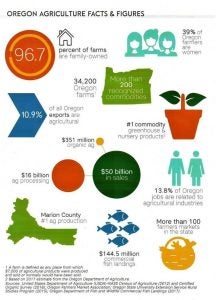
Pennsylvania
Agricultural cash receipts: $6.6 billion
Top commodity: Dairy products
Land-grant: Pennsylvania State University, University Park
According to its Department of Agriculture, Pennsylvania leads the United States in mushroom production, with an annual production of more than 425 million pounds, valuing more than $330.7 million per year. However, the highest commodities in sales include dairy products, cattle and calves, corn, miscellaneous crops, and broilers. With over 53,000 farms on 7.2 million acres of farmland, the agriculture industry is a top industry for the Commonwealth of Pennsylvania.
Rhode Island
Agricultural cash receipts: $59.2 million
Top commodity: Greenhouse and nursery products
Land-grant: University of Rhode Island, Kingston
Agriculture is among Rhode Island’s top industries, along with health services, tourism and manufacturing. In Rhode Island, farmland covers 10 percent with over 60,000 acres being involved in agriculture. The state’s top commodities include greenhouse and nursery products, dairy, sweet corn, chicken eggs, and apples. Although Rhode Island is the smallest U.S. state in means of square footage, it still houses 1,243 farms.
South Carolina
Agricultural cash receipts: $2.1 billion
Top commodity: Broilers
Land-grants: Clemson University, Clemson; South Carolina State University, Orangeburg
Agriculture plays a huge role in South Carolina’s economy — it is the largest industry and supports 200,000 jobs in the state. There are nearly 25,000 farms in South Carolina amounting to nearly 5 million acres of farmland. Top commodities for South Carolina include broilers, turkeys, greenhouse nurseries, cotton, and corn. Although their broilers are a top cash commodity, beef, sheep, dairy, swine, horses, aquaculture, and even specialty animals such as rabbits, emus, ostriches, rheas, llamas, goats and bees are all vitally important to South Carolina agriculture.
South Dakota
Agricultural cash receipts: $8.8 billion
Top commodity: Cattle and calves
Land-grant: South Dakota State University, Brookings
South Dakota may be known for its open spaces and Mount Rushmore, but agriculture is actually its top industry. The value of South Dakota’s agricultural production and processing industries represented 8.5 percent of total state GDP. South Dakota’s top agricultural commodities include cattle and calves, soybeans, corn, hogs, and dairy products. South Dakota farmers plant more than 5 million acres of corn every year, resulting in the sixth largest corn acreage among all states.
Tennessee
Agricultural cash receipts: $3.7 billion
Top commodity: Soybeans
Land-grant: Tennessee State University, Nashville; University of Tennessee, Knoxville
With nearly 70,000 farms on 10 million acres, Tennessee represents a strong agricultural industry. Tennessee’s top commodities include soybeans, corn, cattle and calves, miscellaneous crops, and broilers. With $3.7 billion in agricultural cash receipts, the agriculture industry has a strong impact on the state. Not only is it a huge economic driver, but the industry also employees 342,000 people in Tennessee. Farmland makes up 41 percent of the total land in Tennessee.
Texas
Agricultural cash receipts: $20.2 billion
Top commodity: Cattle and calves
Land-grant: Prairie View A&M University, Prairie View; Texas A&M University, College Station
Everything is bigger and better in Texas — agriculture included. The 2017 Census of Agriculture found that Texas ranks first in the nation for total number of farms with just over 248,000, which account for more than 127 million acres of agricultural land (managing almost 74 percent of the state’s 268,581 square miles). Within those acres, the top commodities included cattle and calves, dairy products, cotton, broilers, and corn. In Texas, one in seven employees are connected to the agriculture industry.
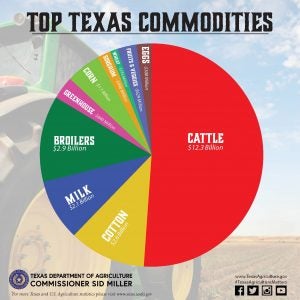
Utah
Agricultural cash receipts: $1.8 billion
Top commodity: Cattle and calves
Land-grant: Utah State University, Logan
Agriculture in Utah could be summed up in one word — expanding. The number of farms expanded by 2 percent between the 2012 and 2017 Ag Census. The top commodities include cattle and calves, dairy products, hay, miscellaneous crops, and chicken eggs. More than 100,000 people in Utah are employed by agriculture and agribusiness. One interesting fact about Utah’s agriculture is that the state is the second largest producer of tart cherries in the country. With nearly 11 million acres, Utah has a diverse agriculture industry.
Vermont
Agricultural cash receipts: $728 million
Top commodity: Dairy products
Land-grant: University of Vermont, Burlington
Vermont might be one of the smaller states, but their agriculture industry is mighty. Vermont is actually America’s largest producer of maple syrup. With over a million acres as farmland, 20 percent of Vermont is farmland. Vermont’s top commodities include dairy products, miscellaneous crops, cattle and calves, maple products, and hay. Dairy farms are the primary farm industry in Vermont, producing more than 2 billion pounds of milk annually.
Virginia
Agricultural cash receipts: $3.3 billion
Top commodity: Broilers
Land-grants: Virginia Tech, Blacksburg; Virginia State University, Petersburg
Virginia’s agricultural production is one of the most diverse in the nation and it is the state’s largest industry. Top commodities include broilers, cattle and calves, miscellaneous crops, turkeys, and dairy products. According to Virginia’s Department of Agriculture and Consumer Services, every job in agriculture and forestry supports 1.7 jobs elsewhere in Virginia’s economy. Agricultural and forestry exports were valued at $2.97 billion in 2018, up from $2.63 billion in 2017.

Washington
Agricultural cash receipts: $9.9 billion
Top commodity: Apples
Land-grant: Northwest Indian College, Bellingham; Washington State University, Pullman
Agriculture is a cornerstone of Washington’s economy, with 39,000 farms operating on more than 15 million acres. Washington is the number one producer of apples, blueberries, hops, pears, spearmint oil, and sweet cherries in the U.S. According to NASDA, Washington is the third largest agricultural exporter in the nation, with $8 billion in agriculture exports. The industry employs 160,000 people across the state. Top commodities for Washington include apples, dairy products, cattle and calves, wheat, and potatoes.
West Virginia
Agricultural cash receipts: $633 million
Top commodity: Cattle and calves
Land-grant: West Virginia State University, Institute; West Virginia University, Morgantown
“Country roads, take me home … “ Not only is West Virginia synonymous with country music, but also country living and the agriculture industry. West Virginia leads the nation in ratio of family-owned farms with 98 percent of their 23,622 farms being family-owned. Top commodities for the Mountain State include cattle and calves, broilers, miscellaneous crops, turkeys, and chicken eggs. With its broken up hilly landscape, row crops provide only 20 percent of share of sales, with livestock accounting for 80 percent.
Wisconsin
Agricultural cash receipts: $11.4 billion
Top commodity: Dairy products
Land-grant: College of Menominee Nation, Keshena; Lac Courte Oreilles Ojibwa Community College, Hayward; University of Wisconsin, Madison
Wisconsin is known for its role in providing high quality dairy products to our nation. According to NASDA, Wisconsin’s 1.28 million dairy cattle produced more than 30 billion pounds of milk, a national leader next to California. While it ranks high in overall production of dairy products, Wisconsin ranks No. 1 in corn for silage, cranberry, and snap bean production. According to the 2017 Census of Ag, Wisconsin had 64,793 farms and 14.3 million acres in farms with an average farm size of 221 acres. Wisconsin’s top commodities include dairy products, cattle and calves, corn, soybeans, and potatoes.
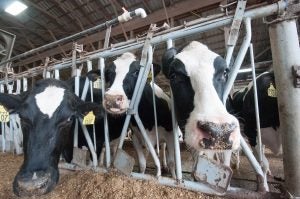
Wyoming
Agricultural cash receipts: $1.5 billion
Top commodity: Cattle and calves
Land-grant: University of Wyoming, Laramie
Last but certainly not least is the wide open spaces of Wyoming. The 2017 Census of Agriculture showed Wyoming producers operated the largest farms and ranches in the U.S. with an average of 2,430 acres per farm, over five times the national average size. Wyoming’s top commodities include cattle and calves, hay, hogs, barley, and dairy products. For the state of Wyoming, 48 percent of the total land area is federally owned.
The beautiful thing about America’s agriculture industry is the vast diversity between states and even regions. No two states are the same, but it takes each and every one of the states and territories and their unique capabilities to make up the amazing industry that we have all come to know and love. The success of the industry comes from the hundreds of thousands of farmers and ranchers, workers, employees, and so many others that dedicate their lives to agriculture.



